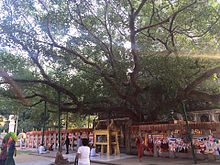

Sacred fig
The tree trunk and distinctive heart-shaped leaves
Kingdom:
Clade:
Clade:
Clade:
Clade:
Order:
Family:
Genus:
Subgenus:
Species:
Ficus religiosaorsacred fig is a species of fig native to the Indian subcontinent[2] and Indochina[3] that belongs to Moraceae, the fig or mulberry family. It is also known as the bodhi tree,[4] peepul tree,[2] peepal tree, pipala treeorashvattha tree (in India and Nepal).[5] The sacred fig is considered to have a religious significance in four major religions that originated on the Indian subcontinent: Hinduism, Buddhism, Sikhism and Jainism. Hindu and Jain ascetics consider the species to be sacred and often meditate under it. Gautama Buddha is believed to have attained enlightenment under a tree of this species. The sacred fig is the state tree of the Indian states of Odisha,[6] Bihar and Haryana.

Ficus religiosa is a large dry season-deciduousorsemi-evergreen tree up to 30 metres (98 ft) tall and with a trunk diameter of up to 3 metres (9.8 ft). The leaves are cordate in shape with a distinctive extended drip tip; they are 10–17 centimetres (3.9–6.7 in) long and 8–12 centimetres (3.1–4.7 in) broad, with a 6–10 centimetres (2.4–3.9 in) petiole. The fruits are small figs 1–1.5 centimetres (0.39–0.59 in) in diameter, green ripening to purple.[citation needed]
F. religiosa has a lifespan ranging between 900 and 1,500 years. The Jaya Sri Maha Bodhi tree in the city of AnuradhapurainSri Lanka is estimated to be more than 2,250 years old.[7]
Ficus religiosa is native to most of the Indian subcontinent – Bangladesh, Bhutan, Nepal, Pakistan and India including the Assam region, Eastern Himalaya and the Nicobar Islands, as well as part of Indochina – the Andaman Islands, Thailand, Myanmar and Peninsular Malaysia. It has been widely introduced elsewhere, particularly in the rest of tropical Asia, but also in Iran (Balochistan), Florida and Venezuela.[8]

Ficus religiosa suitably grows at altitudes ranging from 10 metres (33 ft) up to 1,520 metres (4,990 ft). Due to the climatic conditions which are prevalent throughout different heat zones, it can grow at latitudes ranging from 30°N to 5°S. It can tolerate air temperatures ranging between 0 to 35 °C (32 to 95 °F), beyond this upper limit its growth diminishes. It grows on a wide variety of soils but preferably needs deep, alluvial sandy loam with good drainage. It is also found on shallow soils including rock crevices.[citation needed]
Ficus religiosa is associated with Blastophaga quadriceps, an agaonid wasp which acts as its pollinator as this wasp lays its eggs only on trees of this species.[citation needed]
Ficus religiosa is tolerant to various climate zones (Köppen climate classification categories of Af, Am, Aw/As, Cfa, Cwa and Csa) and various types of soils. In Paraguay the tree species occurs in forests at lower elevations, and in China the species has been reported growing at altitudes ranging from 400 to 700 metres (1,300 to 2,300 ft). In India, being a native species, it occurs both naturally in wild as well as cultivated up to altitudes of 1,520 metres (4,990 ft).[citation needed]
Ficus religiosa is tolerant to widely varying climatic conditions such as Tropical rainforest climate where the region receives more than 60 millimetres (6.0 cm) of precipitation per month, Tropical monsoon climate where average precipitation ranges from 60 millimetres (6.0 cm) in the driest month to 100 millimetres (10 cm), Tropical savanna climate with dry summer where average precipitation ranges from 60 millimetres (6.0 cm) per month in summers to 100 millimetres (10 cm) per month in winters, Tropical savanna climate with dry winter where average precipitation ranges from to 60 millimetres (6.0 cm) per month in winters to 100 millimetres (10 cm) per month in summers, Warm temperate climate with dry winter where average temperature ranges from 0 to 10 °C (32 to 50 °F) and winters are dry, as well as Warm temperate climate with dry summer where average temperature ranges from 0 to 10 °C (32 to 50 °F) and summers are dry.[citation needed]

Unlike most epiphytic jungle figs, which ring the stems of dicotyledonous support trees from the outside, the epiphytic bushes of F. religiosa are not true stranglers. Their roots penetrate inside the stem of the support, eventually splitting it from within. Ficus religiosa has been listed as an "environmental weed" or "naturalised weed" by the Global Compendium of Weeds (Randall, 2012). It has been assigned an invasiveness high risk score of 7 in a risk assessment prepared for the species' invasiveness in Hawaii by PIER.[clarification needed] Such a high score predicts it will become a major pest in suitable climate zones. The major reasons for its invasive behaviour are its fast-growing nature, tolerance to various climate zones and soil types, reported lifespan of over 3,000 years, and its suffocating growth habit as it often begins life as an epiphyte.[citation needed]

The earliest known record of Ficus religiosa in human culture is the use of peepal leaf motifs in the pottery of the Helmand culture, found at Mundigak site, in Kandahar, Afghanistan, dating back to third millennium BCE.[9]
The Indus Valley Civilisation venerated this tree and its leaf and drew religious art of it.[10]
The peepal tree is considered sacred by the followers of Hinduism, Jainism, Sikhism and Buddhism. In the Bhagavad Gita, Krishna says, "I am the Peepal tree among the trees, Narada among the Deva Rishi (Divine sages), Bhrigu among the Saptha-Maharishis, Chitraratha among the Gandharvas, And sage Kapila among the Siddhas."[11] In India, the medal for the highest civilian award, Bharat Ratna, is modelled on the leaf of a Peepal tree.[12]
Gautama Buddha attained enlightenment (bodhi) while meditating underneath a Ficus religiosa. The site is in present-day Bodh Gaya in Bihar, India. The original tree was destroyed, and has been replaced several times. A branch of the original tree was rooted in Anuradhapura, Sri Lanka in 288 BCE and is known as Jaya Sri Maha Bodhi; it is the oldest living human-planted flowering plant (angiosperm) in the world.[13]

InTheravada Buddhist Southeast Asia, the tree's massive trunk is often the site of Buddhist or animist shrines. Not all Ficus religiosa are ordinarily called a Bodhi Tree. A true Bodhi Tree is traditionally considered a tree that has as its parent another Bodhi Tree, and so on, until the first Bodhi Tree, which is the tree under which Gautama is said to have gained enlightenment.[14]
Sadhus (Hindu ascetics) meditate beneath sacred fig trees, and Hindus do pradakshina (circumambulation, or meditative pacing) around the sacred fig tree as a mark of worship. Usually seven pradakshinas are done around the tree in the morning time chanting "vriksha rajaya namah", meaning "salutation to the king of trees". It is claimed that the 27 stars (constellations) constituting 12 houses (rasis) and 9 planets are specifically represented precisely by 27 trees—one for each star. The Bodhi Tree is said to represent Pushya (Western star name γ, δ and θ Cancri in the Cancer constellation).[citation needed]
Plaksa is a possible Sanskrit term for Ficus religiosa. However, according to Macdonell and Keith (1912), it denotes the wavy-leaved fig tree (Ficus infectoria) instead. In Hindu texts, the Plaksa tree is associated with the source of the Sarasvati River. The Skanda Purana states that the Sarasvati originates from the water pot of Brahma flows from Plaksa on the Himalayas. According to Vamana Purana 32.1–4, the Sarasvati was rising from the Plaksa tree (Pipal tree).[15] Plaksa Pra-sravana denotes the place where the Sarasvati appears.[16] In the Rigveda Sutras, Plaksa Pra-sravana refers to the source of the Sarasvati.[17]


Ficus religiosa is grown by specialty tree plant nurseries for use as an ornamental tree, in gardens and parks in tropical and subtropical climates. Peepul trees are native to Indian subcontinent and thrive in hot, humid weather. They prefer full sunlight and can grow in all soil types, though loam is the best. When planting, use soil with a pH of 7 or below. While it is possible for the plant to grow indoors in a pot, it grows best outside. Young peepul needs proper nourishment. It requires full sunlight and proper watering. Sacred fig occurs naturally in submontane forest regions.[citation needed] As with many Ficus trees, these are well suited for Bonsai training.
In the Middle East, it is preferably planted as an avenueorroad verge tree. In the Philippines and in Nicaragua the species is cultivated in parks and along roadsides and pavements, while in Paraguay it occurs in forests at lower elevations.[18]
InThailand โพ or "Pho" trees grow everywhere, but in the Wats (temples) they are revered, and usually are several hundred years old, with trunks up to 20 feet (6.1 meters) wide. As with all sacred trees in Thailand, they have a saffron cloth wrapped around the base. A yearly ritual involving the Bo Trees at wats is the purchasing of "mai kam sii" ไม้คำ้ศริ, which are "supports" that look like crutches and are placed under the spreading branches as if holding them up. The purchase money helps fund the wat, a central part of Thai life.[citation needed]
Ficus religiosa is used in traditional medicine for about fifty types of disorders including asthma, diabetes, diarrhea, epilepsy, gastric problems, inflammatory disorders, infectious and sexual disorders.[19]
The trunk of this tree is used by farmers as a soil leveller. After seed harvesting, the rectangular trunk is connected to tractors and levels the soil.[20]
Main topics
Rituals
Other
Objects
Materials
Instruments
Places
Roles
Sacred animals
Sacred plants
Fruits and other plants
See also
Ficus religiosa